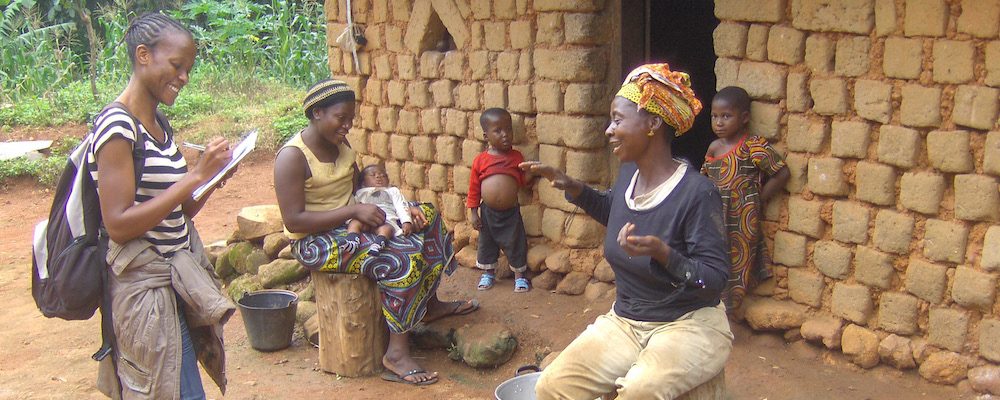Presented at the 55th Conference of the Societas Linguistica Europaea (University of Bucharest) by P. Di Carlo, J. Good, and N. Tschonghongei
Abstract
The Cameroonian Grassfields have long been known for their linguistic diversity (Stallcup 1980). While the region’s hilly topography can lead to spatial separation among settlements, individuals frequently interact across communities and multilingualism is the norm (Warnier 1980). However, local language ideologies draw an important correlation between a group’s political independence and its linguistic singularity. In particular, traditionally, a village is conceptualized as politically independent only when its inhabitants speak a distinctive language variety (Di Carlo & Good 2014). This creates an ideal social setting “favouring linguistic signalling of group-membership distinctions” (Evans 2019:567). In principle, sociopolitical pressures of this kind have the potential to trigger various forms of deliberate language change (Thomason 2007). However, work on this topic for the languages of the Cameroonian Grassfields is nearly non-existent at present, and this paper aims to contribute to a repertoire of cases in which postulating processes of socially-motivated contact-induced language divergence is needed to account for certain linguistic patterns.
In support of its arguments, this paper considers two apparent cases of deliberate language change in the Grassfields, one attested and one inferred. The attested case involves a process of deliberate change at the level of incipient relexification that was initiated around 1990 by residents of the settlement of Kumfutu who were advocating for political independence from the larger village Kuk, where the Kuk language (ISO code [kfn]) is spoken. This process is reported to have started through abrupt innovations for new words for basic lexical items in the local cultural space—such as, e.g., words for ‘fufu’ (a local food staple), ‘raffia wine’, and ‘corn beer’. Even though the plans to achieve political independence and create a new language were later aborted, the event is still vividly remembered by Kumfutu villagers as a source of great tension with the Kuk leadership.
The inferred case concerns the Fang language (ISO code [fak]). Following preliminary work by Mve et al. (2019), some peculiar phonological and morphological features of Fang would be quite difficult to explain unless one posits that speakers favored changes that complexified its nominal and verbal morphology in ways that would make it difficult for outsiders to properly acquire—i.e., the language seems to have been impacted by esoterogeny (Ross 1996). The fact that these changes are paralleled by sociocultural features of its speaker community which promote the separation of Fang society from other nearby groups (e.g., via its system of marital exchange) and by a relatively recent history of prolonged conflict against external threats provides strong support for the analysis of these changes as constituting an instance of socially-motivated divergence as a result of language contact.
These processes of linguistic separation are embedded within a larger sociolinguistic context where language choice at the individual level is a central tool in the maintenance of relationships (Di Carlo et al. 2019). We argue that this social feature plays a crucial role in catalyzing processes of deliberate change specifically and in explaining the exceptional linguistic diversity of the Grassfields more generally.
References
Di Carlo, Pierpaolo & Jeff Good. 2014. What are we trying to preserve? Diversity, change, and ideology at the edge of the Cameroonian Grassfields. In Peter K. Austin & Julia Sallabank (eds.), Endangered languages: Beliefs and ideologies in language documentation and revitalization, 229–262. Oxford: OUP.
Di Carlo, Pierpaolo, Jeff Good & Rachel Ojong Diba. 2019. Multilingualism in rural Africa. Oxford Research Encyclopedia of Linguistics. doi:10.1093/acrefore/9780199384655.013.227.
Evans, Nicholas. 2019. Linguistic divergence under contact. In M. Cennamo & C. Fabrizio (eds.) Historical Linguistics 2015: Selected papers from the 22nd International Conference on Historical Linguistics, Naples, 27-31 July 2015, 564–591. Amsterdam/Philadelphia: John Benjamins.
Mve, Patrick, Nelson T. Tschonghongei, Pierpaolo Di Carlo, and Jeff Good. 2019. Cultural distinctiveness and linguistic esoterogeny: The case of the Fang language of Lower Fungom, Cameroon. In Pius W. Akumbu and Esther P. Chie (eds.), Engagement with Africa: Linguistic essays in honor of Ngessimo M. Mutaka, 163–178. Köln: Rüdiger Köppe.
Ross, Malcolm. 1996. Contact-induced change and the comparative method: Cases from Papua New Guinea. In M. Durie & M. Ross (eds.) The comparative method reviewed: Regularity and irregularity in language change, 180–217. Oxford: OUP.
Stallcup, K. 1980. La géographie linguistique des Grassfields. In L. M. Hyman & J. Voorhoeve (eds.), L’expansion bantoue: Actes du colloque international du CNRS, Viviers (France) 4–16 avril 1977. Volume I: Les classes nominaux dans le bantou des Grassfields, 43–57. Paris: SELAF.
Thomason, Sarah G. 2007. Language contact and deliberate change. Journal of Language Contact. THEMA 1: 41–62.
Warnier, Jean-Pierre. 1980. Des précurseurs de l’école Berlitz: Le multilinguisme dans les Grassfields du Cameroun au 19ème siècle. In Luc Bouquiaux (ed.), L’expansion bantoue: Actes du colloque international du CNRS, Viviers (France) 4–16 avril 1977. Volume III, 827–844. Paris: SELAF.
